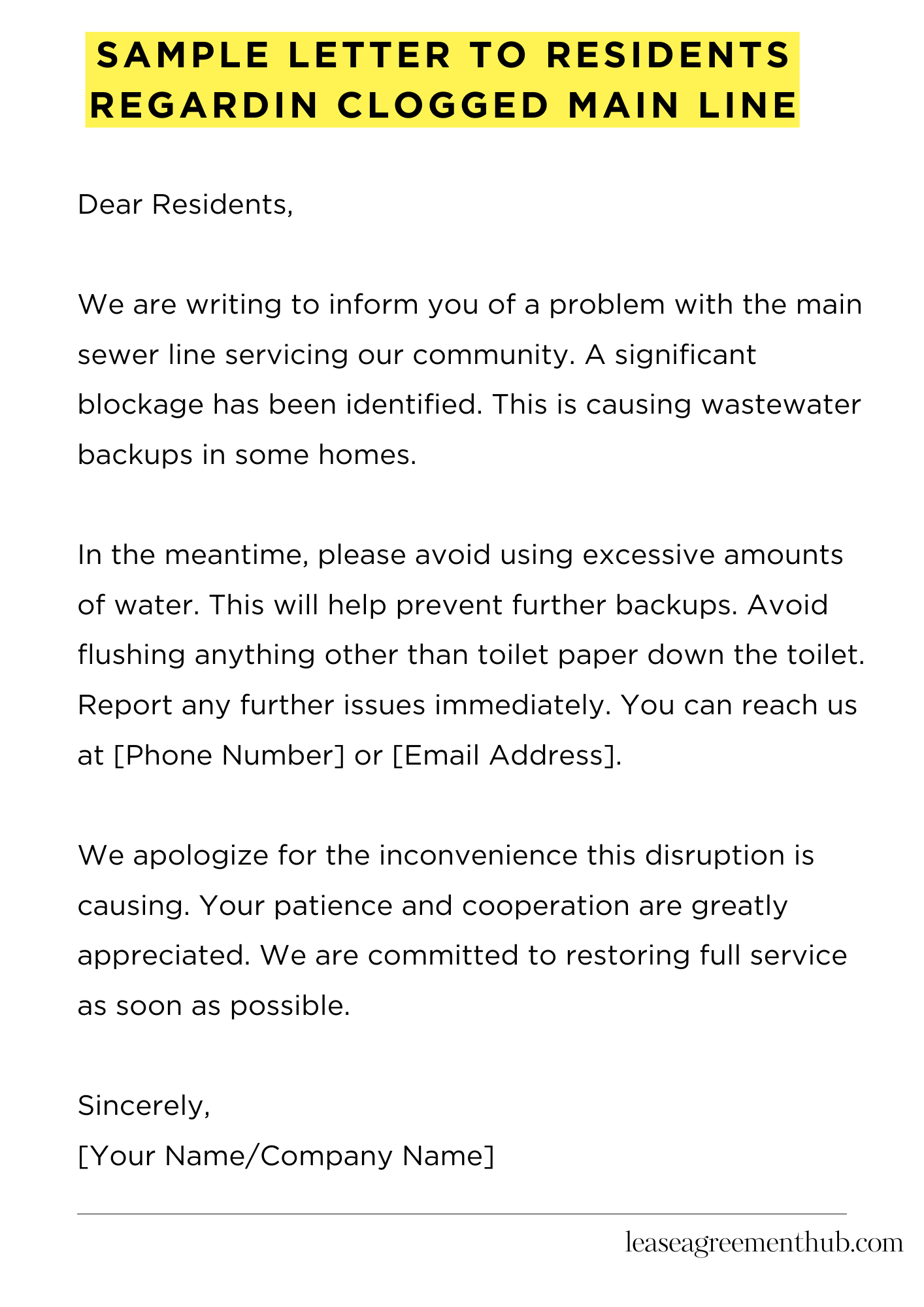A clogged main sewer line is a big problem. It affects everyone. This article helps you tell residents about it.
We’ll give you example letters. Use them as templates. Adapt them to your situation.
These samples make writing easier. They’ll save you time and effort. You can easily modify them.
Sample Letter to Residents Regarding Clogged Main Line
[Your Company Letterhead]
[Date]
Dear Residents,
We are writing to inform you of a problem with the main sewer line servicing our community. A significant blockage has been identified. This is causing wastewater backups in some homes. We understand this is disruptive and inconvenient. Our team is working diligently to resolve this issue as quickly as possible.
The blockage is currently impacting several properties. We are using specialized equipment to clear the line. This process requires careful precision. It may take some time to fully restore service to everyone.
We anticipate the problem will be resolved within [Timeframe, e.g., 24-48 hours]. We will provide updates as the situation progresses. Regular updates will be sent via email and posted on our community website.
In the meantime, please avoid using excessive amounts of water. This will help prevent further backups. Avoid flushing anything other than toilet paper down the toilet. Report any further issues immediately. You can reach us at [Phone Number] or [Email Address].
We apologize for the inconvenience this disruption is causing. Your patience and cooperation are greatly appreciated. We are committed to restoring full service as soon as possible.
Sincerely,
[Your Name/Company Name]

How to Write a Sample Letter to Residents Regarding a Clogged Main Line
Understanding Your Audience: The Crucial First Step
Before even considering the verbiage, consider your audience. Are you communicating with meticulous retirees or harried young professionals? Tailoring your tone and language is paramount. A formal, almost pedantic approach might suit a more senior demographic, while a concise, efficient communication may resonate better with a younger cohort. Remember, clarity trumps all.
Crafting a Compelling Salutation: Setting the Tone
The salutation is your first impression. Avoid generic greetings; instead, strive for a personalized touch whenever feasible. “Dear Residents,” is acceptable, yet “Dear Valued Community Members,” demonstrates a greater level of respect and consideration. Consider using names if you have a manageable number of residents. This seemingly minor detail significantly impacts the overall reception of your communication.
Conveying the Problem: Clarity and Precision
Directly and succinctly address the issue. Avoid obfuscation; plainly state that a blockage in the main sewer line is impacting wastewater disposal. Use unambiguous terminology to prevent misinterpretations. For instance, instead of mentioning “difficulties,” clearly state: “a significant sewer line clog has resulted in a service interruption.” The clarity of this statement will prevent unnecessary anxiety or confusion.
Outlining Remedial Actions: A Roadmap to Resolution
Detail the steps taken and planned to rectify the situation. Specify the contractor engaged, the projected timeframe for repairs, and any interim measures implemented. Transparency is key; residents need to understand the plan and anticipate the resolution’s timeline. Provide contact information for queries or concerns, reassuring them that their issues will be addressed expediently.
Managing Expectations: Addressing Potential Inconveniences
Acknowledge any potential inconveniences this disruption might cause. This demonstrates empathy and proactive management. Be forthright about the temporary disruption to services and apologize for any resulting discomfort. Mitigating potential frustration through open communication builds trust and goodwill.
Maintaining a Professional Tone: Avoiding Jargon and Technicalities
While detailed explanations are necessary, avoid excessive technical jargon. Use simple, easy-to-understand language. Complex terminology can be alienating and create unnecessary confusion. Stick to clear, concise sentences, prioritizing straightforward language that every resident can easily comprehend.
Concluding with a Positive Note: Reinforcing Community Spirit
End with a positive and reassuring message. Express gratitude for residents’ patience and understanding. Reiterate your commitment to resolving the situation swiftly and efficiently. Ending on a positive note leaves a lasting impression of professionalism and collaborative problem-solving, thereby fostering a stronger sense of community.
FAQs about sample letter to residents regarding clogged main line
Communicating effectively with residents about a clogged main line is crucial for minimizing disruption and ensuring cooperation. The following questions address common concerns and offer guidance for crafting a clear and informative letter.
What information should be included in a letter to residents about a clogged main line?
A letter should clearly state the problem (clogged main line), its potential impact (e.g., sewer backup, slowed drainage), the timeframe for resolution, the actions being taken to fix the problem, and any necessary actions residents should take (e.g., avoiding using certain appliances, conserving water). Contact information for further inquiries should also be provided.
How can I ensure the letter is easily understood by residents with varying levels of literacy?
Use plain language, avoiding technical jargon. Short sentences and paragraphs are preferable. Consider using bullet points to highlight key information. You might also offer the letter in multiple languages, if necessary, reflecting the demographics of your community.
What is the best way to distribute the letter to ensure all residents receive it?
Multiple distribution methods often work best. This might include hand-delivery, posting the letter on a community notice board, emailing it (if you have residents’ email addresses), and including it with a regular mailing.
What tone should the letter adopt to maintain a positive relationship with residents?
Maintain a professional, yet empathetic and informative tone. Acknowledge any inconvenience the clog may cause, and express appreciation for residents’ understanding and cooperation. Avoid blaming or accusatory language.
How can I address potential concerns or questions residents may have about the cause of the clogged main line?
Briefly explain the likely cause of the clog (without getting overly technical), while emphasizing the focus is on prompt resolution. You can offer to answer questions or provide further information through the contact details provided.
Related: